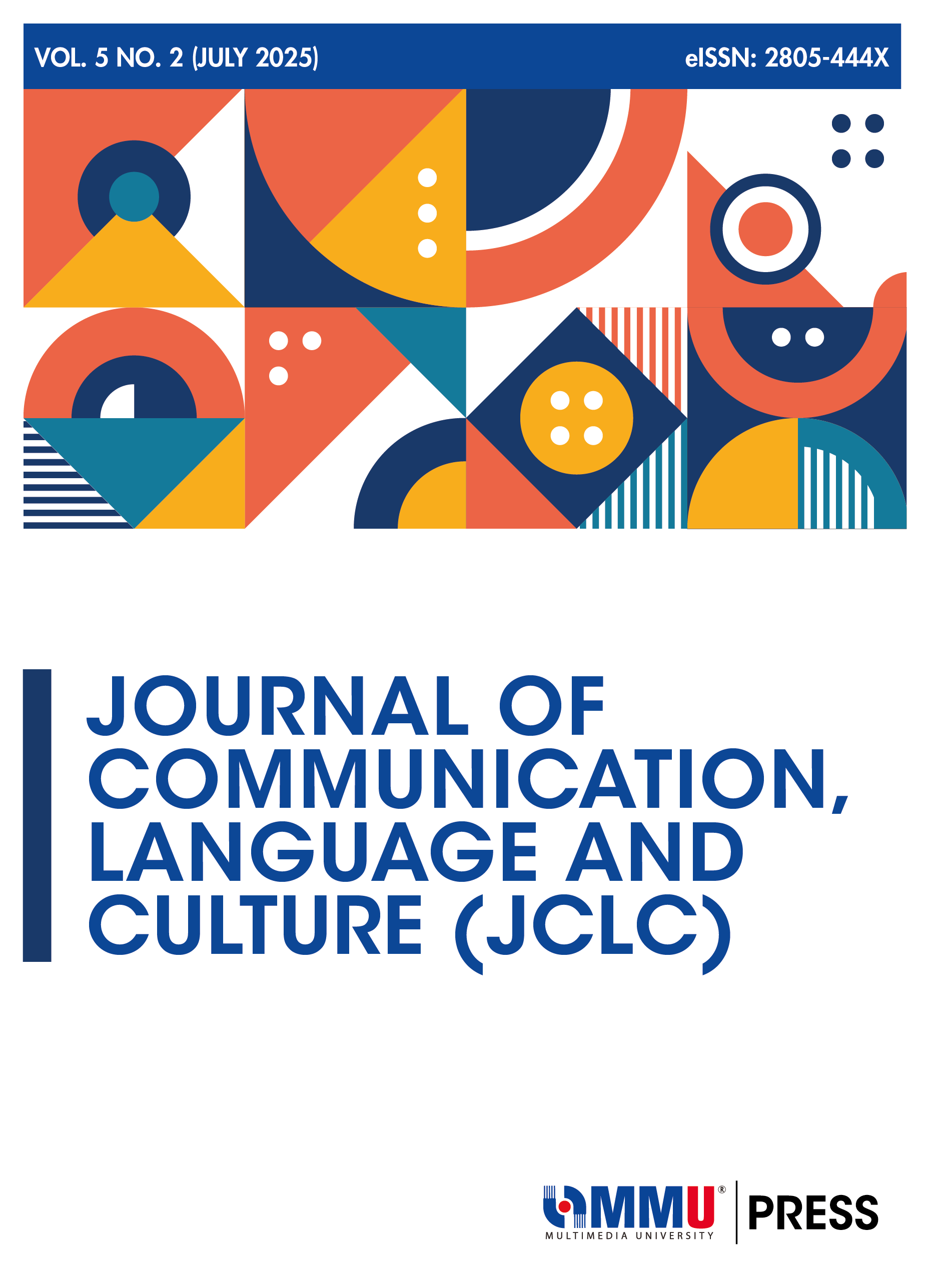A Study of Multimodal Metaphors in the Chinese Environmental Documentary, Behemoth
Main Article Content
Abstract
This study examines how the environmental documentary Behemoth, directed by Zhao Liang, uses metaphor to represent environmental degradation in China, particularly in regions like Inner Mongolia and Shanxi, where industrialization and coal mining have caused severe pollution. Despite its serious impact on public health, awareness among the population remains limited due to institutional constraints that restrict open communication. The objective of this study is to analyse how the documentary uses multimodal metaphors to communicate environmental issues and raise awareness. Drawing on Forceville’s multimodal metaphor theory and using a textual analysis method with coding adapted from Fan’s multimodal metaphor coding sheet, the study identifies how visual, verbal, and textual metaphors are strategically employed. The findings show that Behemoth uses split images, orientation metaphors (e.g., good vs. evil), and metaphors of life (lambs, sheep, coal miners), hope, and religion to emphasize the severity of ecological destruction and position humans as its root cause. These metaphors play a critical role in helping audiences comprehend the scale and impact of environmental crises, suggesting that metaphorical imagery is a powerful tool for environmental communication.
Article Details
References
Chai, J. (Director). (2015). Under the dome [Film]. Independent Production. Retrieved from https://www.youtube.com/watch?v=T6X2uwlQGQM
Chen, W., & Peng, Z. (2020). Metaphoric construction and multimodal narrative of "Cultural China" image. China Television, 2, 83–86.
Dante, A. (2024). The divine comedy. Berkley.
Dong, H., Lin, Y., Zhou, J., Chen, Z., Wang, M., & Liu, J. (2018). Quantifying surface coal-mining patterns to promote regional sustainability in Ordos, Inner Mongolia. Sustainability, 10(4), 1135. https://doi.org/10.3390/su10041135
Fan, J. (2017). Research on dynamic construction of documentary multimodal discourse (Master’s thesis, Northwestern University). CNKI. https://kns.cnki.net/KCMS/detail/detail.aspx?dbname=CMFD201801&filename=1017104583.nh
Forceville, C. (2024). Identifying and interpreting visual and multimodal metaphor in commercials and feature films. Metaphor and Symbol, 39(1), 40–54. https://doi.org/10.1080/10926488.2023.2271544
Gao, G. (2021). Experimental study on the absorption of carbon dioxide by a novel phase change solvent (Master’s thesis, North China Electric Power University). CNKI. https://kns.cnki.net/KCMS/detail/detail.aspx?dbname=CMFDTEMP&filename=1021885729.nh
He, X. (2018). Restrictions on energy and environmental security in my country and related suggestions. Environmental Protection, 9, 46–49. https://doi.org/10.14026/j.cnki.0253-9705.2018.09.010
Hou, X. (2018). Narrative research on environmental protection documentaries (Master’s thesis, Shandong Normal University). CNKI. https://kns.cnki.net/KCMS/detail/detail.aspx?dbname=CMFD201901&filename=1018177561.nh
Huang, Y. K. (2016). A cognitive investigation of love metaphors: A multimodal analysis of sea journey in Titanic (Master’s thesis, National Sun Yat-Sen University).
Lakoff, G., & Johnson, M. (2008). Metaphors we live by. University of Chicago Press.
Li, X. (2018). Research on snake imagery in "Bible Genesis" (Master’s thesis, Northwest Normal University). CNKI. https://kns.cnki.net/KCMS/detail/detail.aspx?dbname=CMFD201901&filename=1018163505.nh
Li, X., Zhang, Y., Liu, Y., Chen, X., Zhang, J., & Ding, X. (2020). Land subsidence related to coal mining in China revealed by L-band InSAR analysis. International Journal of Environmental Research and Public Health, 17(4), 1170. https://doi.org/10.3390/ijerph17041170
Li, Y. (2020). Study on the decomposition of carbon emission drivers and decoupling effect of logistics industry in Yangtze River Delta region (Master’s thesis, South China University). CNKI. https://kns.cnki.net/KCMS/detail/detail.aspx?dbname=CMFD202101&filename=1020077342.nh
Liu, Q. (2016). Between the real and the imaginary: The poetic construction of the independent documentary "Sorrowful, Warcraft". Drama House, 5, 129–130.
Obert, M. (Director). (2013). Song from the forest [Film]. Tondowski Films.
Qin, B. (2016). Dynamic multimodal discourse analysis of environmental protection documentaries (Master’s thesis, Southwest University).
Su, C., Peng, Y., & Huang, S. (2020). A metaphor comprehension method based on culture-related hierarchical semantic model. Neural Processing Letters, 51, 2807–2826. https://doi.org/10.1007/s11063-020-10227-6
Thibodeau, P. H., Matlock, T., & Flusberg, S. J. (2019). The role of metaphor in communication and thought. Language and Linguistics Compass, 13(5), e12327.
Tian, H., & Sun, H. (2022). Ecocritical research in the context of "desire theory": Current status, core issues and alleviation paths. Theoretical Monthly, 3, 153–160. https://doi.org/10.14180/j.cnki.1004-0544.2022.03.017
Wu, M. (2017). Songs from hell: A study of the lamentations of modern Chinese coal mines. People's Music, 5, 66–69.
Yan, N. (2020). Contemporary Chinese movie "Mirror" image research (Master’s thesis, Jiangxi Normal University). CNKI. https://kns.cnki.net/KCMS/detail/detail.aspx?dbname=CMFD202002&filename=1020637903.nh
Yang, Y. (2018). On the use of visual rhetoric in ecological films (Master’s thesis, Wuhan University). CNKI. https://kns.cnki.net/KCMS/detail/detail.aspx?dbname=CMFD202001&filename=1018194042.nh
Yu, X., Wang, G., & Yang, F. (2015). Investigation and research on the epidemiological characteristics of pneumoconiosis in Ordos City from 2010 to 2014. Occupation and Health, 21, 2876–3041. https://doi.org/10.13329DOIcnki.zyyjk.2015.0995
Zhang, M. (2020). Climate change in Chinese newspapers 2000–2020: Discursive strategies of consolidating hegemony. Academia.edu. https://www.academia.edu/91134907/Climate_Change_in_Chinese_Newspapers_2000_2020_Discursive_Strategies_of_Consolidating_Hegemony
Zhou, Q. Y. (2020). Research on the problems faced by China's urbanization process and countermeasures. Industry and Technology Forum, 1, 8–9.
Zhuang, R. (2018). Ideological declaration from Chinese Cyberspace Administration. Wired. https://www.wired.com/beyond-the-beyond/2018/11/ideological-declaration-chinese-cyberspace-administration

